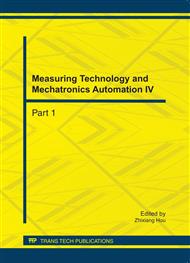[1]
Qiong Wang, Jingyu Yang, Mingwu Ren. Driver Fatigue Detection: A Survey[C]/ Proceedings of the 6th World Congress on Intelligent Control and Automation, 2006: 21 – 23.
DOI: 10.1109/wcica.2006.1713656
Google Scholar
[2]
Saroj K. L. Lal, Ashley Craig, A critical review of the psychophysiology of driver fatigue[J]. Biological Psychology, 2001, 55(3): 173-194.
DOI: 10.1016/s0301-0511(00)00085-5
Google Scholar
[3]
Zutao Zhang, Jiashu Zhang. A New Real-Time Eye Tracking for Driver Fatigue Detection[C] /6th International Conference on ITS Telecommunications Proceedings, 2006: 8-11.
DOI: 10.1109/itst.2006.288748
Google Scholar
[4]
Qiang Ji, Xiaojie Yang. Real-time eye, gaze, and face pose tracking for monitoring driver vigilance[J]. Real-Time Imaging archive, 2002, 8(5) : 357 – 377.
DOI: 10.1006/rtim.2002.0279
Google Scholar
[5]
Z. Zhou, and X. Geng. Projection function for eye detection[J]. Pattern Recognition, 2004, 37: 1049-1056.
DOI: 10.1016/j.patcog.2003.09.006
Google Scholar
[6]
X. Deng, C. H. Chang, E. Brandle. A new method for eye extraction from facial image[C]/ Preceding of the Second IEEE international Workshop on Electronic Design, Test and Applications. 2004: 29-34.
DOI: 10.1109/delta.2004.10048
Google Scholar
[7]
Wang, Q and J. Yang. Eye location and eye state detection in facial images with unconstrained background[J]. Journal of Information and Computer Science, 2006, 1(5): 284-289.
Google Scholar
[8]
Wen-Hui Dong, Xiao-Juan Wu. Driver Fatigue Detection Based on the Distance of Eyelid[C]/ IEEE Int. Workshop VLSI Design & Video, 2005: 28-30.
DOI: 10.1109/iwvdvt.2005.1504626
Google Scholar
[9]
Mohamad Hoseyn Sigari. Driver Hypo-Vigilance Detection based on Eyelid Behavior[C] /Seventh International Conference on Advances in Pattern Recognition 2009: 426-429.
DOI: 10.1109/icapr.2009.108
Google Scholar
[10]
Y. Tian, T. Kanade and J. Cohen. Eye-state Action Unit Detection by Gabor Waveltes [C]/International Conference on Multimodal Interfaces, 2000: 143-150.
DOI: 10.1007/3-540-40063-x_19
Google Scholar
[11]
Wen Bing Horng, Chih Yuan Chen, Yi Chang, etc. Driver Fatigue Detection Based On Eye Tracking and Dynamic Template Matching[C]/Proceeding of the IEEE International Conference on Networking, Sensing & Control, 2004. 21-23.
DOI: 10.1109/icnsc.2004.1297400
Google Scholar
[12]
Z. Savas, TrackEye. Real time tracking of human eyes[Z]. http: /www. codeproject. com /KB/cpp/TrackEye. aspx, 2010. 3.
Google Scholar
[13]
Rafael C. Gonzalez, Digital Image Processing[M]. 2nd. Ed. 2002, Prence Hall.
Google Scholar
[14]
Lei Yunqi, Yuan Meiling, Song Xiaobing, etc. Recognition of Eye States in Real Time Video[C]/ International Conference on Computer Engineering and Technology. 2009: 554-559.
DOI: 10.1109/iccet.2009.105
Google Scholar
[15]
Zhang Wenchao, Shan Shiguang, Gao Wen, etc. Local Gabor binary pattern histogram sequence (LGBPHS): A novel non-statistical model for face representation and recognition[C]/ Internat. Conf. on Computer Vision, 2005: 786–791.
DOI: 10.1109/iccv.2005.147
Google Scholar
[16]
Tai Sing Lee. Image Representation using 2D Gabor Wavelets[J]. IEEE Transactions ON Pattern Analysis And Machine Intelligence, 1996, 18(10): 959-971.
DOI: 10.1109/34.541406
Google Scholar
[17]
Liu, Chengjun, Wechsler, Harry. Gabor feature based classification using the enhanced Fisher linear discriminant model for face recognition. IEEE Trans. On Image Process[J]. 2002, 11(4): 467–476.
DOI: 10.1109/tip.2002.999679
Google Scholar
[18]
Lawrence R. Rabiner. A Tutorial On Hidden Markov Models and Selected Applications in Speech Recognition[C]/Proceedings of the IEEE, 1989, 77(2): 257-286.
DOI: 10.1109/5.18626
Google Scholar


